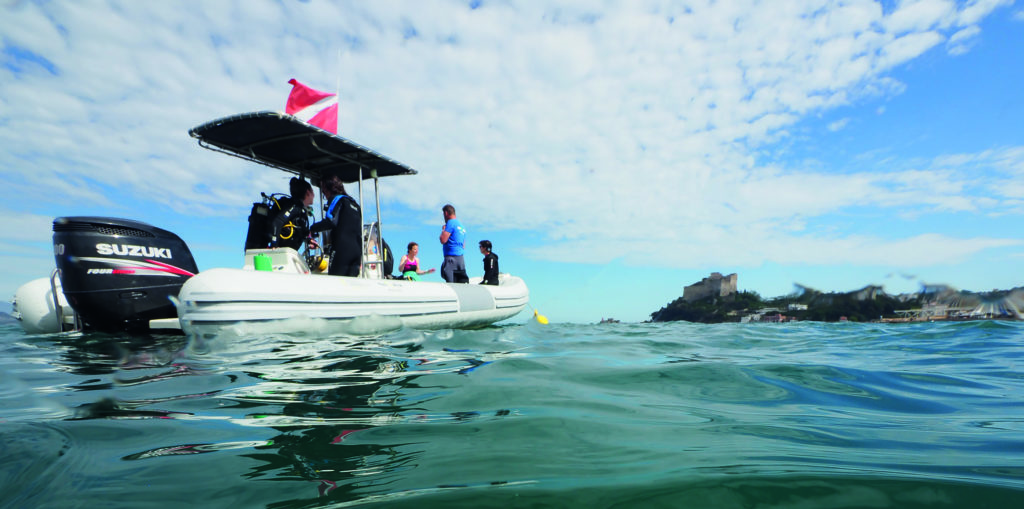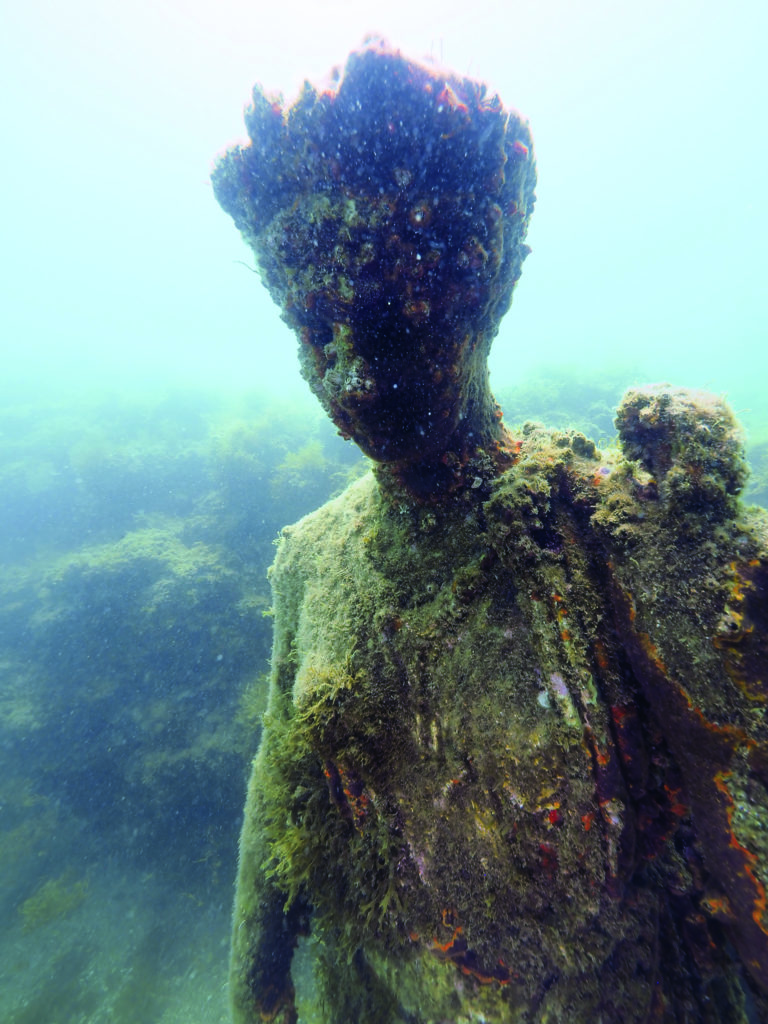DEAN MARTIN was intrigued by tales of a submerged Roman city in Adriatic waters, and his subsequent exploration of this archaeological wonder more than matched the hype
While on a trip to Naples, I had heard about a place where you could literally dive back into history. In its heyday, the classical Roman city of Baia was the hedonistic Las Vegas of the time, but now its remains are partying beneath the waves. As divers, we' a’re honoured to be able to visit these amazingly preserved historical relics.
Exploring the ruins of Baia
Baia was situated on the north-west shore of the Gulf of Naples, in the area that is now Bacoli. It was a fashionable resort for centuries, particularly towards the end of the Roman Republic, when it was reckoned to be superior to Pompeii, Herculaneum and Capri by the super-rich of the day. They were building luxurious villas there for six centuries, from around 100 BC to 500 AD.
Baia was located over natural volcanic vents, and so was renowned for its healing medicinal hot springs, which could be found all around the city and were quite easy to build spas above. It was also notorious for its hedonism, and the attendant rumours of corruption and scandal.
Unfortunately the good times were not to last, and the city was sacked by Saracens in the 8th century. By 1500, the remains of the once-luxurious town had been abandoned. After the city’s remains had emptied of people, the sea level slowly rose because to those same volcanic vents that had once been such a draw to the area, and most of the ancient ruins were drowned under the shallow waters of the bay.
Recent underwater archaeology has revealed many of the fine buildings, statues and roads in varying states of disrepair, and now they are protected in the archaeological park that is open for scuba divers and snorkellers to visit.
I arrived at Subaia Dive Centre and was greeted by Penelope and Ornella, who spoke fantastic English. There was a mixture of divers from the USA, Canada and another couple from the UK, and Ornella proceeded to explain all about Baia’s luxury villas, how they had come to end up sunk into the sea, and which areas we would be diving on this excursion.
Magnificent mosaics
The day consisted of two shallow dives on the Roman remains, with neither of them more than 5m deep. It being so shallow – and thus suitable for any level of diver – you can easily use the same cylinder for both dives, so no tank-swapping is needed.
Our dive-guide explained that on the first dive we would be see mosaic floors. After entering the water from the RIB we were to follow him down to the seabed and form a semi-circle in front of him.
Both mosaics were made of black and white stones and covered by a thin layer of sand that protects them from algae and marine organisms. Moving gently, our guide would start to waft away the sediment to expose what lay below.
We watched as these works of art appeared before our eyes, amiring the hexagonal shapes with geometrical features on one floor, and the images of two men fighting on the other. Both were astoundingly well preserved, considering that they were more than 2,000 years old, and almost looked as if they had been created the previous day.
We took it in turns to capture images before the exquisite floors were covered back up for their protection. Once the sand had been carefully put back into place, you would have swum over the area blissfully unaware of what lay below. We proceeded back to the boat to await our next encounter, chattering excitedly.
The Nymphaeum of Emperor Claudius
We moved to a new mooring not too far away, close to Epitaffio Point, and started to kit up again. This time we were going to be diving on the Nymphaeum of Emperor Claudius, basically a huge villa where Caesar and his friends came to sate their decadent desires.
Dropping into the beautiful blue waters of the Mediterranean, we followed our guide and were awed by the gigantic scale of what we saw. It must have been awe-inspiring in its heyday.
All that is left now are remnants of the walls and foundations, but you can still make out the rectangular shape of the main room, with a semi-circular apse at the bottom and four niches on the long sides.
This monstrous slab of marble flooring had two semi-circles worn into it, and the dive-guide had asked us beforehand to look for this and try to work out what had caused it. Seeing it first-hand, it became obvious that this was the grand entrance, and that the semi-circles were the result of wear and tear caused by the massive doors opening and closing.
There was a vast array of statues in and around the villa, some upright, some prone on the seabed, with others jauntily poking up out of the sand. Some represent members of the emperor’s family, such as his mother Antonia Minore, with a child in her arms representing maternity, and his daughter Octavia Claudia.
Other statues highlighted the luxurious purpose of the room – two of them represented Bacchus, the god of wine and wild animals; while a scene from Homer’s epic Odyssey was represented by the statues of Odysseus and Baios offering wine to the Cyclops Polyphemus as they plan to escape from his cave.
The stone “heroes“ Ulysses and Baio were the first two statues discovered in Baia, but the figure of the cruel one-eyed giant against whom they were scheming is still missing.
After visiting the Nymphaeum, our dive continued along the extraordinary Herculanea road to an ancient Roman baths. At one time this mighty road had led to Portus Julius, one of Rome’s most important harbours. It was commissioned into existence in 37 BC by the acclaimed military leader and engineer Agrippa, and the remains of docks, cisterns and repair workshops can still be seen.
Conclusion
I am always intrigued by unusual dive-sites, and the underwater archaeological park of Baia ticks all the boxes. As divers, we are among the relative few who are able to explore beneath the surface of the sea and appreciate its marine life and topography, but at Baia, our submerged exploits allow us a window into the past, back to a time when Rome ruled the world and thr city was one of the first seaside getaways.
The relics are in fantastic condition, given how long they have been under water, especially those carefully hidden and protected mosaic floors, and the Baia experience is one that will remain with me forever.
Photographs by Dean Martin
Also on Divernet: Dive & Dig: ’More Secrets To Reveal’, On The Cilento Coast






( Persian ) درود ، از خواندن گزارش شما لذت بردم و برایم هیجان انگیز بود ، آفرین بر شما و همکاران برای چنین عملیات مفید و روشنگرانه ای که انجام دادید ، من در ایران و شهر تهران موفق به خواندن گزارش شما شدم ، ایکاش می شد که با تهیه عکسهای متعدد از کف دریا مدل کوچکی از آنها در خشکی ساخت ، ما ایرانیان روی دهها هزار سال تاریخ زندگی میکنیم
فراموش نکنیم که تمدن کهن اروپا و ایزان خواهر خوانده هم هستند ، کتاب شاهنامه که یکهزارسال پیش توسط فردوسی حماسه سرای ایرانی نوشته شده مبدا مهاجرت تمام آریاییان جهان را سرزمین ایران میداند و بدقت حوادث تاریخی آنرا شرح داده است ، دوست من موفق باشید ، برایتان آرزوی تندرستی و بهروزی میکنم ،
دوست تو در ایران
دکتر بیژن جعفری